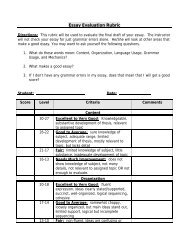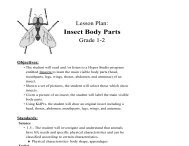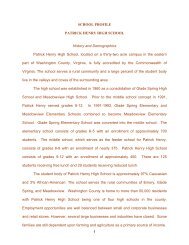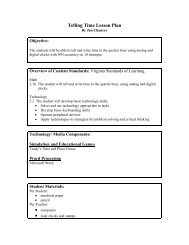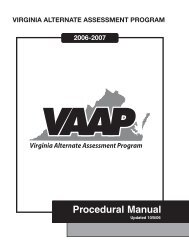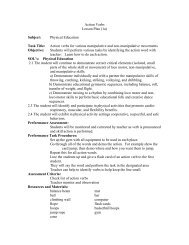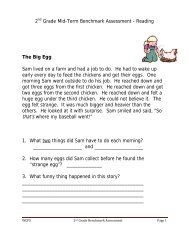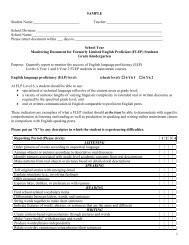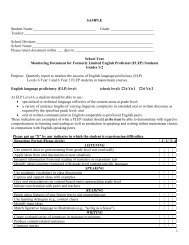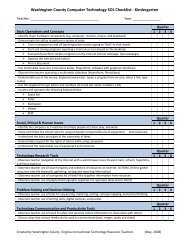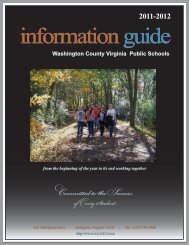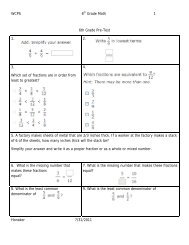Three Little Pigs [v6.0].cwk
Three Little Pigs [v6.0].cwk
Three Little Pigs [v6.0].cwk
You also want an ePaper? Increase the reach of your titles
YUMPU automatically turns print PDFs into web optimized ePapers that Google loves.
The <strong>Three</strong> <strong>Little</strong> <strong>Pigs</strong>Reading Unit for First GradebyBetty S. Wymerillustration from The <strong>Three</strong> <strong>Little</strong> <strong>Pigs</strong>, a <strong>Little</strong> GoldenBook, as told by Eliabeth Ross, illus. by ROFry,Western Publishing, New York, 1973Objectives:The studen will listen to several selections presented orally and identifythe characteristics that make each a fairy tale as evidenced by orallycompleting the It’s A Fairy Tale-Characteristics of Fairy Tales chart.The student will orally compare and contrast several versions of The<strong>Three</strong> <strong>Little</strong> <strong>Pigs</strong> by completing a chart on the key elements of eachstory.The student will practice putting events and ideas into a logicalsequence using teacher-made activities and the 1-2-3 Sequence Mecomputer program.The student will illustrate and put story events in sequence to retell oneversion of the <strong>Three</strong> <strong>Little</strong> <strong>Pigs</strong> for a HyperStudio program.The student will use a variety of reading skills and strategies toindependently read a simple version of The <strong>Three</strong> <strong>Little</strong> <strong>Pigs</strong>.The student will read with expression and fluency one section of aretelling to record into a HyperStudio program.
Standards:Oral Language1.1 The student will continue to demonstrate growth in the use of orallanguageListen and respond to a variety of media, including books,audiotapes, videos, and other age-appropriate publications.Retell stories in logical orderParticipate in a variety of oral language skills1.2 The student will continue to expand and use listening and speakingvocabularies.1.3 The student will adapt or change oral language to fit the situation.Use appropriate voice level in small-group settings.Ask and respond to questions in small-group settings.Reading/Literature1.5 The student will apply knowledge of how print is organized andread.1.7 The student will use meaning clues when reading.Use knowledge of the story and topic to read words.1.9 The student will integrate phonetic strategies, meaning clues, andlanguage structure when reading.Set a purpose for reading.Read with accuracy and self-correct when reading1.10 The student will read familiar stories with fluency and expression.1.11 The student will read and comprehend a variety of fiction andnonfiction selections.Identify characters and settingRetell stories and events, using beginning, middle, and end.Writing1.12 The student will write to communicate ideas.Focus on one topicUse complete sentences in final copies.Begin each sentence with a capital letter and use endingpunctuation in final copies.Share writing with othersUse available technology
Teacher Strategies/TasksThe teacher will introduce students to the genre of fairy tales bylisting basic key elements.The teacher will read a variety of traditional fairy tales to thestudents and record student responses for each story on the It’s AFairy Tale chart.The teacher will provide several different versions of The <strong>Three</strong><strong>Little</strong> <strong>Pigs</strong>.The teacher will provide copies of illustrations and sentences froma easy-to-read version of The <strong>Three</strong> <strong>Little</strong> <strong>Pigs</strong> for students to putin sequential order.The teacher will make a chart for comparing key elements ofdifferent versions of The <strong>Three</strong> <strong>Little</strong> <strong>Pigs</strong>.The teacher will provide students with a Story Map to use in retellinga selected version of the <strong>Three</strong> <strong>Little</strong> <strong>Pigs</strong>.The teacher will design a HyperStudio program to present theretelling of one version of The <strong>Three</strong> <strong>Little</strong> <strong>Pigs</strong> with studentillustrations and student recordings of the reading of the studentwritten text.Student Strategies/Tasks:Direct Instruction StrategyDrill and PracticeThe student will practice putting ideas in logical sequence using thecomputer program 1-2-3 Sequence Me by SunburstCompare and ContrastThe student will identify similarities and differences in versions ofThe <strong>Three</strong> <strong>Little</strong> <strong>Pigs</strong> using criteria developed along with theteacher.Guide for Reading, ListeningThe student will use charts of key elements of The <strong>Three</strong> <strong>Little</strong> <strong>Pigs</strong>stories to search out important details in stories heard and read.The student will use a Story Map to identify main points of aselected version of The <strong>Three</strong> <strong>Little</strong> <strong>Pigs</strong> to include in a retellingof the story.Explicit Teaching-Independent PracticeThe student will take at least one story event and write it into a completesentence.
`Indirect Instruction StrategyConcept MappingThe student will use a chart of key elements of fairy tales toidentify the elements present in a variety of fairy tales.Listening/Reading for MeaningThe student determine the settings in different versions of the The<strong>Three</strong> <strong>Little</strong> <strong>Pigs</strong> read or heard.The student will use the text to make inferences as necessary to fillin information on a story map and to complete a timeline for aselected story.Reflective DiscussionThe student will be involved in small-group discussions aboutsettings and time periods of versions of the <strong>Three</strong> <strong>Little</strong> <strong>Pigs</strong>.Interactive Instruction StrategyPeer PracticeThe student will work with peers to practice reading a simpleversion of The <strong>Three</strong> <strong>Little</strong> <strong>Pigs</strong>.The student will work with his/her peers to arrange events from aselected version of The <strong>Three</strong> <strong>Little</strong> <strong>Pigs</strong> in chronological order.The student will work with his/her peers to practice orally reading asection of the retelling for recording into the HyperStudioprogram.BrainstormingThe student will brainstorm to activate prior knowledge aboutkey elements of fairy tales.The student will brainstorm to identify key events from the versionof The <strong>Three</strong> <strong>Little</strong> <strong>Pigs</strong> chosen for retelling.Experiential Instruction StrategyIllustrating imagesThe student will illustrate a section of the retelling to show his/herideas.
ResourcesBooksRead aloudThe True Story of the <strong>Three</strong> <strong>Little</strong> <strong>Pigs</strong> by Jon Scieszka, et al.The <strong>Three</strong> <strong>Little</strong> <strong>Pigs</strong> and the Fox: An Appalachian Tale by William H.Hooks, S. D. Schindler (Illustrator)<strong>Three</strong> <strong>Little</strong> Hawaiian <strong>Pigs</strong> and the Magic Shark by Donivee LairdThe Fourth <strong>Little</strong> Pig by Teresa Clesi, et alThe <strong>Three</strong> <strong>Little</strong> Javelinas by Susan Lowell, Jim Harris (Illustrator)The <strong>Three</strong> <strong>Little</strong> <strong>Pigs</strong> by Steven Kellogg (Illustrator)The <strong>Three</strong> <strong>Little</strong> <strong>Pigs</strong> by James Marshall (Illustrator)The <strong>Three</strong> <strong>Little</strong> Wolves and the Big Bad Pig by Eugene Trivigas,Helen Oxenbury (illustrator)Ziggy Piggy: And the <strong>Three</strong> <strong>Little</strong> <strong>Pigs</strong> by Frank AschThe <strong>Three</strong> <strong>Little</strong> <strong>Pigs</strong>: An Old Story by Margot ZemachShared ReadingWe Both Read: The <strong>Three</strong> <strong>Little</strong> <strong>Pigs</strong> by Deu Ross, Erin MarieMauterer (Illustrator)Beginning Readers for Independent ReadingThe <strong>Three</strong> <strong>Little</strong> <strong>Pigs</strong> (Modern Curriculum Press Beginning to Readseries), Margaret HillertThe <strong>Three</strong> <strong>Little</strong> <strong>Pigs</strong> (Puffin Easy-to-Read, Level 2) by Harriet Ziefert,Laura Rader (Contributor)The <strong>Three</strong> <strong>Little</strong> <strong>Pigs</strong> (Ready-To-Read). Paul Meisel (Illustrator), BettyMiles- told primarily through dialogueThe <strong>Three</strong> <strong>Little</strong> <strong>Pigs</strong>, Keep Books, Early Learning Initiative at TheOhio State UniversitySoftwareHyperStudio- full edition for teacher; player for students1-2-3 Sequence Me by Sunburst
Hardware1 computer (minimum)with microphonePrinterDigital camera/scanner for putting student illustrations intoHyperStudio programCharts (teacher-made)Elements of Fairy Tales to display in classIt’s A Fairy Tale chart to note elements of fairy tales contained invariety of selections read to the studentsChart to compare versions of The <strong>Three</strong> <strong>Little</strong> <strong>Pigs</strong>Story Map - classroom sizeAssessmentFormativeThe teacher will monitor all class discussions/activities to informallyassesslevel of student interest,student comprehension of selections presented,understanding of fairy tale elements,ability to not likenesses and differences among several versionsof the same fairy tale,ability to support inferences with details from texts,accuracy in putting events in logical/chronological order, andability to read and understand emergent/easy textSummativeStudent writing will be evaluated to see if student has written acomplete sentence with beginning capitalization and endingpunctuation.Student illustration will be evaluated to see if it matches and supportsthe given text.Independent reading will be evaluated for level of accuracy (95%),fluency, and expression.The story map will be evaluated to see that it matches the order of eventspresented in the text.


![Three Little Pigs [v6.0].cwk](https://img.yumpu.com/50082322/1/500x640/three-little-pigs-v60cwk.jpg)
